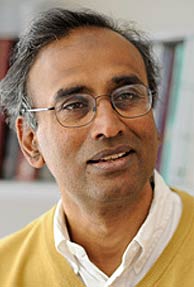London: Indian-origin Scientist Venkatraman Ramakrishnan shares the Nobel Prize in Chemistry this year with Thomas A. Steitz and Ada E. Yonath, it was announced in Stockholm Wednesday.
The Royal Swedish Academy of Sciences said that the Nobel Prize in Chemistry for 2009 awards studies of one of life's core processes: the ribosome's translation of DNA information into life. Ribosomes produce proteins, which in turn control the chemistry in all living organisms. As ribosomes are crucial to life, they are also a major target for new antibiotics, it said in a statement. 
Born in 1952 in Chidambaram, Tamil Nadu, Ramakrishnan did his B.Sc. in Physics (1971) from Baroda University in Gujarat and later migrated to the U.S. to continue his studies where he later got settled and attained U.S. citizenship. He earned his Ph.D in Physics from Ohio University in the U.S. and later worked as a graduate student at the University of California from 1976-78. Ramakrishnan, now a Senior Scientist at the MRC Laboratory of Molecular Biology in Cambridge has authored several important papers in academic journals.
Ramakrishnan and Steitz are U.S. citizens while Yonath is from Israel. Ramakrishnan joins an illustrious list of Indians and people of Indian origin, who have won the Nobel Prize in various disciplines - including Rabindranath Tagore, C.V. Raman, Hargobind Khorana, Mother Teresa, S. Chandrashekhar and Amartya Sen.
Ramakrishnan, Steitz and Yonath have been awarded for showing what the ribosome looks like and how it functions at the atomic level. All three have used a method called X-ray crystallography to map the position for each and every one of the hundreds of thousands of atoms that make up the ribosome.
"Inside every cell in all organisms, there are DNA molecules. They contain the blueprints for how a human being, a plant or a bacterium, looks and functions. But the DNA molecule is passive. If there was nothing else, there would be no life," a statement from the academy of sciences said.
The blueprints become transformed into living matter through the work of ribosomes.
An understanding of the ribosome's innermost workings is important for a scientific understanding of life. This knowledge can be put to a practical and immediate use; many of today's antibiotics cure various diseases by blocking the function of bacterial ribosomes. Without functional ribosomes, bacteria cannot survive. This is why ribosomes are such an important target for new antibiotics, the statement added.
This year's three Laureates have all generated 3D models that show how different antibiotics bind to the ribosome. These models are now used by scientists in order to develop new antibiotics, directly assisting the saving of lives and decreasing humanity's suffering.
The Royal Swedish Academy of Sciences said that the Nobel Prize in Chemistry for 2009 awards studies of one of life's core processes: the ribosome's translation of DNA information into life. Ribosomes produce proteins, which in turn control the chemistry in all living organisms. As ribosomes are crucial to life, they are also a major target for new antibiotics, it said in a statement.
Born in 1952 in Chidambaram, Tamil Nadu, Ramakrishnan did his B.Sc. in Physics (1971) from Baroda University in Gujarat and later migrated to the U.S. to continue his studies where he later got settled and attained U.S. citizenship. He earned his Ph.D in Physics from Ohio University in the U.S. and later worked as a graduate student at the University of California from 1976-78. Ramakrishnan, now a Senior Scientist at the MRC Laboratory of Molecular Biology in Cambridge has authored several important papers in academic journals.
Ramakrishnan and Steitz are U.S. citizens while Yonath is from Israel. Ramakrishnan joins an illustrious list of Indians and people of Indian origin, who have won the Nobel Prize in various disciplines - including Rabindranath Tagore, C.V. Raman, Hargobind Khorana, Mother Teresa, S. Chandrashekhar and Amartya Sen.
Ramakrishnan, Steitz and Yonath have been awarded for showing what the ribosome looks like and how it functions at the atomic level. All three have used a method called X-ray crystallography to map the position for each and every one of the hundreds of thousands of atoms that make up the ribosome.
"Inside every cell in all organisms, there are DNA molecules. They contain the blueprints for how a human being, a plant or a bacterium, looks and functions. But the DNA molecule is passive. If there was nothing else, there would be no life," a statement from the academy of sciences said.
The blueprints become transformed into living matter through the work of ribosomes.
An understanding of the ribosome's innermost workings is important for a scientific understanding of life. This knowledge can be put to a practical and immediate use; many of today's antibiotics cure various diseases by blocking the function of bacterial ribosomes. Without functional ribosomes, bacteria cannot survive. This is why ribosomes are such an important target for new antibiotics, the statement added.
This year's three Laureates have all generated 3D models that show how different antibiotics bind to the ribosome. These models are now used by scientists in order to develop new antibiotics, directly assisting the saving of lives and decreasing humanity's suffering.
No comments:
Post a Comment